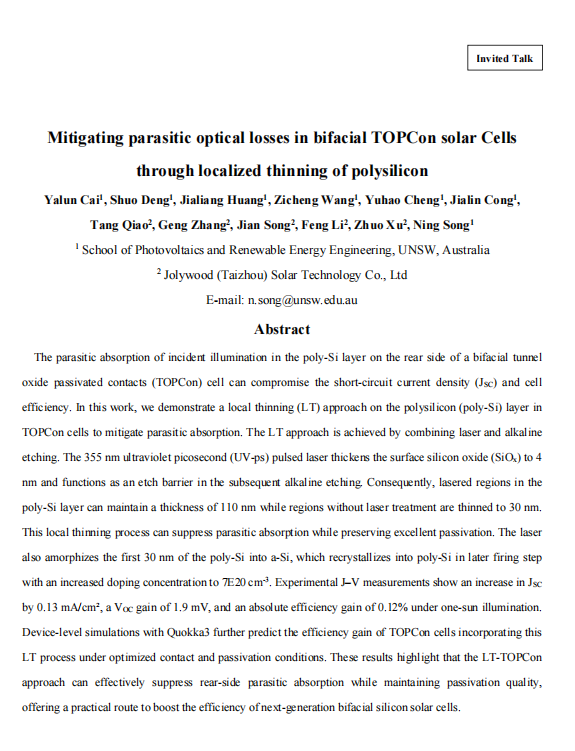| Mitigating parasitic optical losses in bifacial TOPCon solar Cells through localized thinning of polysilicon【Ning Song 】 |
| 发布时间:2025-11-02 | 浏览次数:13 |
Mitigating parasitic optical losses in bifacial TOPCon solar Cells through localized thinning of polysilicon Yalun Cai1, Shuo Deng1, Jialiang Huang1, Zicheng Wang1, Yuhao Cheng1, Jialin Cong1, Tang Qiao2, Geng Zhang2, Jian Song2, Feng Li2, Zhuo Xu2, Ning Song1 1 School of Photovoltaics and Renewable Energy Engineering, UNSW, Australia 2 Jolywood (Taizhou) Solar Technology Co., Ltd E-mail: n.song@unsw.edu.au Abstract The parasitic absorption of incident illumination in the poly-Si layer on the rear side of a bifacial tunnel oxide passivated contacts (TOPCon) cell can compromise the short-circuit current density (JSC) and cell efficiency. In this work, we demonstrate a local thinning (LT) approach on the polysilicon (poly-Si) layer in TOPCon cells to mitigate parasitic absorption. The LT approach is achieved by combining laser and alkaline etching. The 355 nm ultraviolet picosecond (UV-ps) pulsed laser thickens the surface silicon oxide (SiOx) to 4 nm and functions as an etch barrier in the subsequent alkaline etching. Consequently, lasered regions in the poly-Si layer can maintain a thickness of 110 nm while regions without laser treatment are thinned to 30 nm. This local thinning process can suppress parasitic absorption while preserving excellent passivation. The laser also amorphizes the first 30 nm of the poly-Si into a-Si, which recrystallizes into poly-Si in later firing step with an increased doping concentration to 7E20 cm-3. Experimental J–V measurements show an increase in JSC by 0.13 mA/cm², a VOC gain of 1.9 mV, and an absolute efficiency gain of 0.12% under one-sun illumination. Device-level simulations with Quokka3 further predict the efficiency gain of TOPCon cells incorporating this LT process under optimized contact and passivation conditions. These results highlight that the LT-TOPCon approach can effectively suppress rear-side parasitic absorption while maintaining passivation quality, offering a practical route to boost the efficiency of next-generation bifacial silicon solar cells.
|






